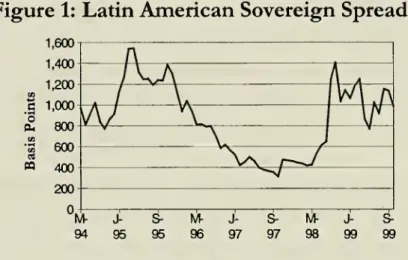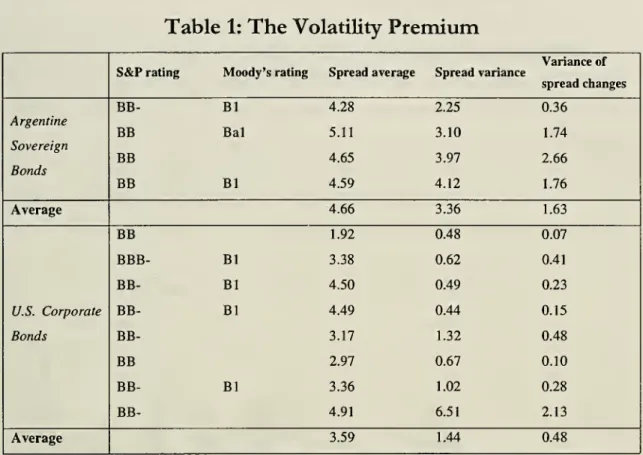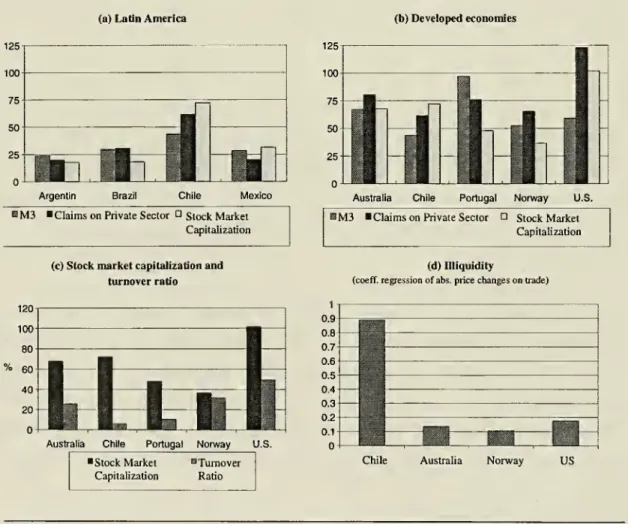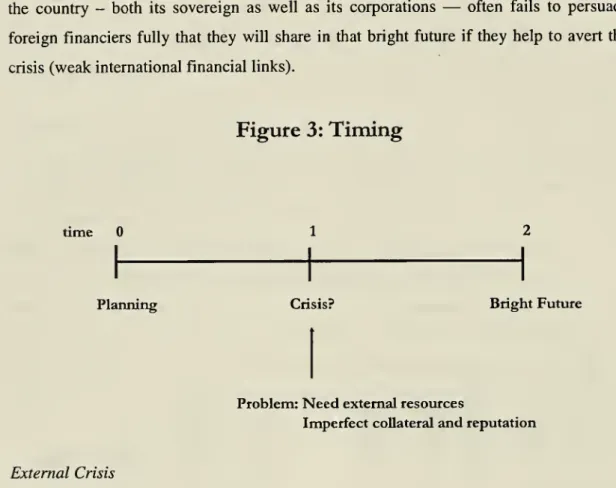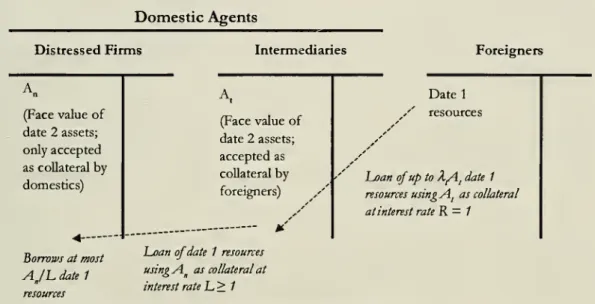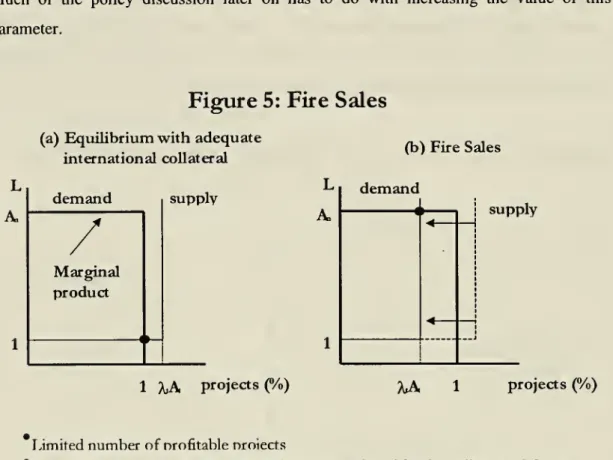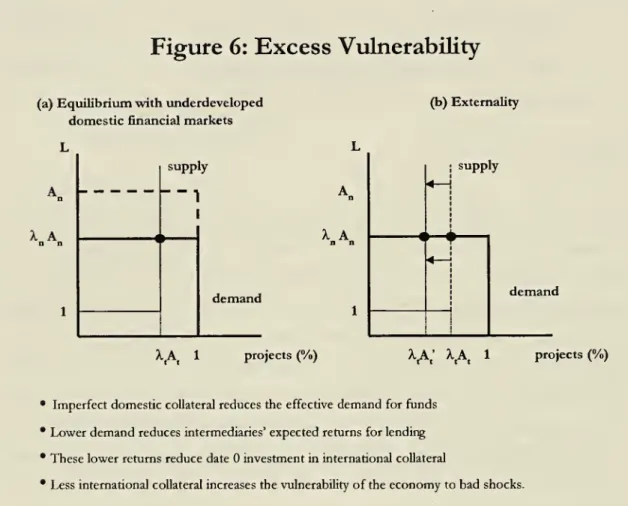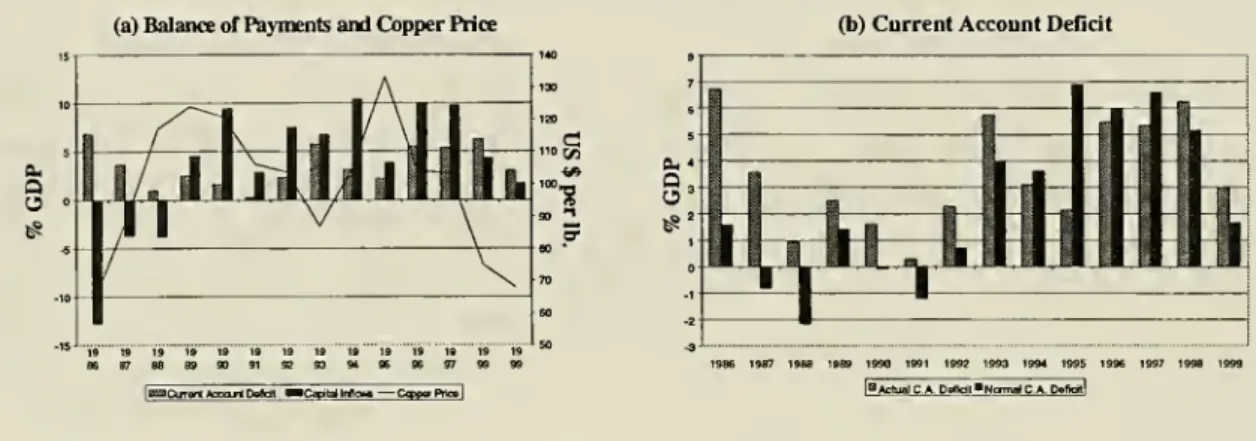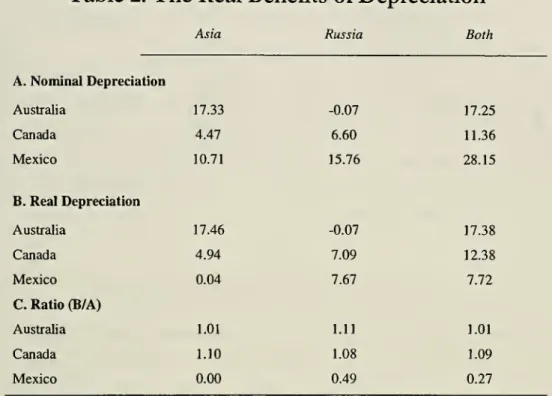*
/
\
*
LIBRARIES
^oSTtf^
Digitized
by
the
Internet
Archive
in
2011
with
funding
from
Boston
Library
Consortium
Member
Libraries
HB31
DEWEY
.M415
1.1
Massachusetts
Institute
of
Technology
Department
of
Economics
Working Paper
Series
AGGREGATE
VOLATILITY
IN
MODERN
LATIN
AMERICA: CAUSES
AND
CURES
Ricardo
J.Caballero
Working
Paper
00-11
June
2000
Room
E52-251
50
Memorial
Drive
Cambridge,
MA
02142
This
paper
can
be downloaded
without
charge
from
the
Social
Science
Research
Network
Paper
Collection
atMASSACHUSETTSINSTITUTE
OFTECHNOLOGY
OCT
2
5 2000
Massachusetts
Institute
of
Technology
Department
of
Economics
Working
Paper
Series
AGGREGATE
VOLATILITY
IN
MODERN
LATIN
AMERICA:
CAUSES
AND
CURES
Ricardo
J.Caballero
Working
Paper
00-11
June
2000
Room
E52-251
50
Memorial
Drive
Cambridge,
MA
02142
This
paper
can
be
downloaded
without
charge
from
the
Social
Science
Research Network Paper
Collection
atAggregate
Volatility
in
Modern
Latin
America:
Causes
and
Cures
By
Ricardo
J.Caballero
2May
31,
2000
I.
Introduction
Latin
America
hasexperienceddeep
transformationsduring the 1990s. Inmany
countries of the region traditional imbalanceshave
been
largely abated, privatizations are widespread,openness
of both tradeand
financial accounts hasbeen
largely accomplished, supervisoryand enforcement
institutions are steadily improving, pension systemshave been
modernized,and
so on.Symptoms
of successabound.An
important exception to this rosyscenario is theuntamed and widespread
volatility of realand
financial variables.3 In afew
countries, this volatility is still explainedby
thetraditional maladies that plagued Latin
America
in earlier decades—
namely,
chronic fiscal imbalancesand
political instability—
perhapsdue
to also chronicincome
inequality— lackof export diversification,
and
failedpolicyexperiments.However,
those countriesthathave
largelytamed
these traditionalproblems
arestillaffectedby
volatility,although
now
of amore
subtle financial origin, not unlike that recently affecting East Asia.These
financial factors are oftencompounded
by
leftoverweaknesses
resultingfrom
themismatch between
the dramatic increase in financial activity "required"by
the post-Brady era,and
theshortage ofinstitutionaland
human
capital infrastructure createdby
nearly adecade
ofpost-debt-crisisturmoiland
financial repression.While
some
ofthese financial factors areundoubtedly
apart ofthenew
globaleconomy
--inparticularthe greaterflexibility
and
options forcapitalas well as thehighly-leveraged1FirstDraftMarch29,2000.PreparedfortheWorldBank'sLCRFY00flagshipreport"DealingwithEconomicInsecurity
inLatinAmerica."
2MITandNBER.IthankAdamAshcraftforoutstanding researchassistance,and IndermitGill,WilliamMaloneyandLuis
nature of
many
ofthese investors—
a significantcomponent
oftheproblems
associated withthem
can be attributed to domesticweaknesses
present ineven
themost advanced
economies
of the region. It is theseweaknesses
that I attempt to identify here, as theymost
likelyrepresent the primary LatinAmerican
challenge in the nearfuture.With
this objective, the bulk ofthe evidence presented here corresponds to the recent experiences ofArgentina, Chile,and Mexico,
threeofthemost advanced economies
inthe region.Rather than attempting to characterize every possible
shock
and
amplificationmechanism,
this paperoffers a parsimonious account ofvolatility in countries thathave
already
tamed most
of the traditional sources ofmacroeconomic
instability in Latin America. It buildson
two
widelyobserved weaknesses: (i)weak
links with internationalfinancial markets,
and
(ii)underdeveloped
domestic financial markets.Once
interacting,these
two
ingredients not onlyexplain the observedvolatilitybut theyalsogenerate clearexternalities that require policy intervention. This
framework
thus provides a clear foundation for policy analysis.Most
other shocksand
deficiencies are leveraged-
even
made
possible-
by
thesetwo
factors.Moreover,
to the frustration of highlycompetent
policymakers,the
environment
becomes
intolerantofpolicy mistakes.II.
Diagnostic
and
Analysis
In thissectionIprovideaconceptual
framework,
hopefully flexibleenough
tobe
adapted to a broad set ofcircumstances, albeit preciseenough
to speculateon
policy issues.The
firstand
main
part ofthis sectionpresents theessenceoftheframework,
while thesecond
partdiscusses a
few
canonical shocksand
their impact within the outlinedenvironment.4 Irefer tothese parts as "thecore" (of the analysis)and
"the periphery," respectively.3SeeIPES(1995)foranexcellentandforcefulexposition
ofLatinAmerica'svolatilityproblem.
4Theessenceoftheconceptualframework
isanadaptationofthat inCaballeroand Krishnamurthy(1999, 2000). The
examplesandapplicationsaremostlyfromCaballero(1999a,b,c). Allofthesepapers can bedownloaded from http://web.mit.edu/caball/www.
11.1
The
Core
The
IngredientsEmerging
economies
are distinctly characterizedby
two
fundamental weaknesses: (i) aweak
link to international financial markets,and
(ii)underdeveloped
domestic financial markets.One
can think ofthesetwo
ingredients as the core, in the sense thateven
after addressingthetraditional imbalances theyremain
presentand
readytocauseand
leverage crises. Iprovidesome
evidenceforeach
ofthesekey
ingredientsbelow.A.
Weak
international financial links.These
are simply financial constraints, possibly time-varying, that limit the publicand
private internationalborrowing
(broadly understood) ofemerging
countries.Weak
links to international financial markets limitthe
smoothing
of shocks over timeand
are themselves a source of shocks, creating excessivevolatilityintherealeconomy.
The
evidence for this is substantial. Just to highlight afew dimensions
of this problem, consider:i) Quantities.
An
immediate
piece of evidence is that LatinAmerican
economies, unlikeOECDs,
typically exhibit pro-cyclical fiscal deficits.As
standardmacroeconomic
stabilizationarguments
indicate that these deficits ought to be counter-cyclical, this pattern hasbeen
interpreted as a seriously sub-optimal policy,and most
likely the result of the financial constraints facedby
thegovernments
themselves. Additional evidence is presentin theverylow
levelsof currentaccount deficitswhen
compared
to a neoclassicalbenchmark,
or the large swingsincapitalflowsthatbearlittlerelation-
atleastinterms ofmagnitude
-
tochanges
infundamentals.ii) Prices.
There
is alsoevidence offinancial constraints in the price data. Figure 1 illustrates the path of an index of sovereign spreads for LatinAmerica's
largesteconomies
over thesecond
half of the 90s.The
large surge in these spreads aroundtheMexican
and
Russian crises, starkly illustrates themassive
withdrawal ofmuch-needed
foreignsupportforLatinAmerican
assets.Figure
1:Latin
American
Sovereign
Spreads
1,600
Note:thetimeseriesisanaverage ofArgentina,Brazil,Mexico,andVenezuela.
iii) (Self-fulfilling?) Volatility
premium.
Moreover,
while less thanprime
corporateassets in the U.S. also suffered during the Asian
and
Russian crises, the rise in theirpremia
was
substantially smaller. This difference can also be appreciated over longer time intervals. Table 1, for example,compares
theperformance
of several Argentine sovereignbonds
with that ofseveral U.S. corporatebonds
of equivalentrating.The
tablereports the average spreads oftheseinstruments over U.S. Treasury instruments, as well as the variance of these spreadsand
that of theirchanges.The
evidenceillustrates that, relative toU.S. corporate bonds, LatinAmerican bonds pay
a higher spreadand
their returns are substantiallymore
volatile.
Moreover,
thespread-premium
is probably a result of this "excess volatility" that mostlycomes
from
episodeswhen
financial markets tighten foremerging
markets. LatinAmerican
bonds
look "illiquid"from
the point ofview
of spreads
and
volatility, despite the fact that theirvolume
is oftenmuch
largerthat thatofthe specificU.S. corporate
bonds
describedin thetable.7Table
1:The
Volatility
Premium
S&P
rating Moody'srating Spread average SpreadvarianceVarianceof spread changes BB- Bl 4.28 2.25 0.36 Argentine Sovereign Bonds
BB
BB
BB
Bal Bl 5.11 4.65 4.59 3.10 3.97 4.12 1.74 2.66 1.76 Average 4.66 3.36 1.63BB
1.92 0.48 0.07BBB-
Bl 3.38 0.62 0.41 BB- Bl 4.50 0.49 0.23 U.S. Corporate BB- Bl 4.49 0.44 0.15 Bonds BB- 3.17 1.32 0.48BB
2.97 0.67 0.10 BB- Bl 3.36 1.02 0.28 BB- 4.91 6.51 2.13 Average 3.59 1.44 0.48Notes: Spreadaveragemeansaverage overbondlifetime (or startingat earliestdateavailableinDatastream).ArgentineSovereign
Bonds:ARGENTINA-PARG/R93-23,ARGENTINA113/8%97-17,ARGENTINA 11%96-06,ARGENTINA83/8%93-03.
U.S.Corporate Bonds:FRUITOFTHE
LOOM
7%81-11,MAXUS ENERGYCORP.DEB81/2%89-08,SEACONTAINERS121/2%93-04(B),SEACONTAINERS12
%%
92-04(A),AKSTEELHOLDINGCORP.103/4%94-04,CLARKOILREFINING9 1/2%92-04,BETHLEHEMSTLCORP.DEB8.45%86-05,TRSP.MARIT1MAMEXICO91/4%93-03.
Source:BonddatafromDatastream.
B.
Underdeveloped domestic
financial markets.Turning
to thesecond
ingredient, thedevelopment
of domestic financial markets is instrumental not only in fostering investmentand
growth, but also in aggregating resources during distress.Underdeveloped
financial markets limit theprompt
reallocation of resources, creating wasteful contractions in those marketsmost
affectedby
shocks or lessplugged
into thefinancial system.
On
the otherhand, asfinancialdevelopment
rises so does leverage,and
with it the vulnerability of the financial system to shocks also increases.
Many
Latin7Theconclusionsmustbeinterpretedcautiously,since
American
economies
have
suffered at both ends: chronic financial repressionand
underdevelopment
and,when
moving
away
from
that, large collapse of thebanking
system.
Most
significantly, following Caballeroand Krishnamurthy
(1999, 2000), I will arguebelow
that it is this domesticunderdevelopment
that naturally creates externalities that justifymacroeconomic
policiesaimed
atimproving
the country's international liquiditymanagement.
Later
on
Idiscuss "shocks" tothedomestic financial sector,while hereI simply highlight thelow
level ofdevelopment
ofmost
LatinAmerican
financial markets.For
this,consider
two
basic featuresofthesemarkets:Figure
2:Latin
America's Level
Problem
(a)LatinAmerica
125
100
Argentin Brazil Chile Mexico
SM3 "ClaimsonPrivateSector DStockMarket
Capitalization
(c)Stockmarketcapitalizationand
turnoverratio
120
Australia Chile Portugal Norway U.S. StockMarket
Capitalization
8 Turnover Ratio
(b)Developed economies
Australia Chile Portugal Norway U.S.
8M3 ClaimsonPrivateSector StockMarket
Capitalization
(d)niiquidity
(coeff.regressionofabs.pricechangesontrade)
Australia Norway
i)
Low
levels. Figure2
highlights LatinAmerica's
"level problem." Regardless ofhow
it is measured,and
despite significantimprovements
over the last decade, LatinAmerica's
financial marketsand
level of financial intermediation are sub-standard. In panels (a)and
(b) it is clear thatM3,
loans,and
stockmarket
capitalization, each relative to
GDP,
fare poorly with respect toOECD
economies.ii) Illiquidity.
Even
when
the standardmeasures
offinancial depth are atworld
class levels, there is always evidence of underdevelopment.The
dark bars in panel (c)confirm that in terms ofstock
market
capitalization values, Chile is an outlier intheregion
and
fares wellcompared
tomore
advanced
economies.The
light bars, oon
the otherhand, reflectthatChile has avery substandard turnoverratio. Panel (d)reports theresultsof runningasimpleregression ofthe absolutevalue ofdaily pricechanges
(ameasure
of volatility)on
thechange
in the fraction of total capitalization traded. Literally interpreted, it revealsthaton
average an increase in thevolume
traded, in terms oftotal capitalization value, is associated with an increase inprice volatility thatis aboutten timeslarger in Chile than in countries withpresumably
betterdeveloped
financial markets.A
SimpleModel
With
the help ofafew
diagrams, in this section Ioutline a structure to think through themacroeconomic
consequences
-
and
later on, the policy implications-
ofthetwo
core-ingredientshighlightedabove.It is not too farfetched to think about an
emerging economy's
timeline in the terms described in Figure 3.Date
corresponds to"normal"
times,when
investment, planning8Whileexcessivechurn canbewasteful,
itishighly unlikelythatChile'sdepressedlevelsareenoughtosupportasolid
infrastructureof market makersable toprovide optimallevelsof immediacy andliquidity.Moreover,onecould arguethat
thewastes associated withnormal churnare acostworthpayingtoreducethe extentofsystemicliquiditycriseswhenthese
arise.Thisisathemeworthresearching furtherinthecontextof emerging economies.
and
prevention are all very relevant.A
significant part of this planning has todo
with anticipatingand
preventing acrisisin theperhaps not too distantfutureat date 1.Date
2
represents the future, alwaysbrighterthan the present, buta significant obstacle is thatthe country
-
both its sovereign as well as its corporations—
often fails to persuade foreign financiers fully that they will share in thatbright future ifthey help to avert thecrisis
(weak
international financial links).Figure
3:Timing
time
Planning Crisis? BrightFuture
Problem:
Need
external resourcesImperfectcollateral
and
reputationExternal Crisis
Figure
4
describes the elements creating a crisis driven entirelyby
insufficient external resources, butwith a perfectly functioningdomestic financialsystem
-
thatis,when
only the first ingredient is present.We
can think ofa crisis as a timewhen,
(a) a significantfraction of firms or
economic
agents are inneed
of financing to either repay debt orimplement
new
investmentsneeded
to save high return projects,and
(b)on
net, theeconomy
as awhole
needs substantial externalresources butdoes
nothave
enough
assetsand
commitment
to obtain them. Loosely, I refer to these assetsand
commitment
as"collateral,"
which
needsnotbe
interpretedliterally as pledged assetsbutasthe resourcesthat are likely to
be recouped
by
a lender. In order tomake
things as stark as possible,imagine thatdistressedfirms
have no
assetsof value to foreigners, butthatthe high date2
returnon
their investment if successfully maintained,A
n, is fully pledgeable to otherdomestic agents.
To
be concrete, think ofA
n as the value of a building (nontradeable)delivered atdate 2,
and assume
thatabsent a crisis the discount offutureflows is simply zero, the internationaldiscountrate.The mass
ofthese projectsisone.Figure
4:
Equilibrium
in
Domestic
Financial
Markets
Domestic
Agents
DistressedFirms Intermediaries Foreigners
(Face valueof date2assets; onlyaccepted as collateralby domestics) (Face valueof date2assets; acceptedas collateralby foreigners) Datel resources Loanofupto
^
lA
l date1 resourcesusingA
: ascollateral atinterestrateR
=
/ BorrowsatmostAJL
date 1 resourcesLoanofdate1 resources
usingA. ascollateralat
interestrate
L
>
1•Distressedfirmshaveprofitableprojectsbutneeddate1 resources
•Foreignersrequirecollateral
when
lendingdate 1 resourcesatthe internationalinterest rate•Onlydomesticintermediaries
own
internationally-acceptedcollateralOther domestic firms
and
investors (orforeign specialists)have
assets,A
t , that are"good
collateral" toforeigners.
For
example, U.S. T-bills, the presentvalue of exportsas well as other domestic assets —liketelecoms—
thatmay
bedeemed more
transparentand
trustable
by
foreign investors.As
is highly unlikely that foreignerswould
be willing to providefinancing equivalenttothe full valueoftheseassets-due
toa sovereign problem,for
example—
assume
thatone
unit ofA
t only secures a loan of A< date 1 resources.Much
of the policy discussion lateron
has todo
with increasing the value of thisparameter.
L
A.
Figure
5:
Fire Sales
(a)
Equilibrium
with adequate
international collateral
demand
Marginal
product
supply
1XA
projects(%)
(b) FireSalesL
demand
A,supply
kA
1 projects(%
Limited
number
ofprofitablenroiects"Scarcityofinternationalcollaterallimitsthetransfer
of
fundstodistressed firms•
A
decline inthequality ofacountry'sinternationalcollateral can cause a firesaleDomestic
financialmarkets are essentially the placewhere up
toXtA
tdatel resources aremade
availableto the distressedfirms,who
have
date2
assetsA
nto pledgein exchange.When
theeconomy's
pledgeable resources are greater than the needs ofdistressed firms, arbitrage keeps the internal cost of fundsL
equal to the international interest rate (normalizedtoone
here), all distressedfirms are abletoborrow
funds,and
onlya fraction ofdomesticcollateralA
nneeds tobe pledged. Thisis thecaseinpanel(a) of Figure5. Inthis simple example,
where
all projectshave
thesame
highreturn, the domesticdemand
for international liquidity
by
distressedfirmsis flatup
tothe pointwhere
all projects arefully refinanced.
The
supply,on
the other hand, is flat at the international interest rate1'Thus,
inaddition tobindingmicroeconomicincentiveproblems,theremaybesovereignriskassociated tomanyofthese
assets,especially intheeventofcrises.Thelatteraffectsforeigners'valuationoftheseassetsevenwhenthey acquire the
until international collateral A^At runs out,
where
itbecomes
vertical.12When
the aggregate needs of distressed firms are greater than pledgeable resources, competitionamong
distressedfirmstransfersalloftheirprivate surplus (returnabove
the internationalinterest rate) to the domestic suppliers ofinternationalliquidity. Panel (b) illustrates this fire sale ofdomestic assets.
The
fraction ofprojects financed isAtA
t<1,and
the discountof domesticcollateral
jumps
from
one, the internationallevel, toL
=
A
n>1
.
Externality
and
PolicyProblems
Under-provision.
While
the scenario describedabove
can indeed represent a greatsource ofuncertaintyand
volatility for a country, it is not clear that there is a role for policy,aside
from
structural ones (see section III). Since domestic providers of international liquidityare transferred allofthe surplusduring crises,they are given therightincentivesto supply this liquidity. It is here
where
thesecond
ingredienthighlightedabove
plays acentral role.
When
domestic financial markets are imperfect in the sense that distressed firms without direct access to international financial marketsdo
nothave
themeans
to fullypledge theirreturns to otherdomestics orinformed
investors, the ex-ante incentiveto
hoard
and
supply international liquidity isweakened.
Market-making
is not a great businessin amarket
withconstraineddemands.
Imperfectdomestic financial markets are capturedhereby
the assumptionthatonly a fraction \n<\ ofa distressed firm's value canbe
pledged.Panel(a) in Figure
6
illustratesthe scenariojustdescribed.Given
thedate allocations, a decline in A„reduces the effectivedemand
(payment
capacity) ofinternational liquidity.While
the marginal product curveremainsunchanged
(dashed line), the effectivedemand
curve (solid line) shiftsdown
as themaximum
payment
per unit of investment is onlyprivatecontrolrights
12These abrupt changesinslopesareonlymeantto captureas clearly aspossiblethefactthatthereareregionswheremost
firmscansatisfytheirfinancialneedsandthe costofcreditisdeterminedbyinternationalconditions,andotherswhereits
thedomesticavailabilityofinternational assets thatdeterminessuchcost.
A„An.
As
long as pledgeable assets are greater than the opportunity cost of funds (the international interestrate),however,
domestic providers willmake
theseloans.Figure
6:
Excess
Vulnerability
(a)Equilibrium with underdeveloped domesticfinancialmarkets
(b)Externality X
A
supply " -1demand
XA
i supply 14—
I 1 1 1 1 1 • 1 1T
demand
|lA
t 1 projects(%) A.A,' A. (A
t 1 projects(%)• Imperfectdomesticcollateralreduces theeffectivedemandforfunds •Lowerdemandreducesintermediaries'expectedreturnsforlending
•Theselowerreturnsreducedate investmentin international collateral
•Lessinternational collateralincreasesthevulnerabilityoftheeconomytobadshocks.
But
domestic availability of international collateral will notremain unchanged.
In this environment, frictions in themarket
for domestic assets distort the private returns of holding domesticand
international collateral.The
ex-ante equilibrium response to such distortion atdate is capturedinpanel (b), with aninward
shiftin the ex-ante supply of international liquidity/collateral. Since domestic financial constraints limit the returns receivedby
international liquidity providersbelow
the full return ofdistressed projects,the incentive to provide such liquidity declines. In so doing, the
economy
experiencesmore
frequentfire salesand
more
severe distress inthe event of an international squeezeon
the country.The economy
is in theend
made
too vulnerable to external shocks asNotethatadeclinein
L
does notnecessarilyimplythatthedomesticinterest ratefallsrelative tothecase withbetterdeveloped domesticfinancialmarkets(forgiveninternationalliquidity).Itmay
implyinsteadthata largershareofthedomestic "loan"becomesuncolletaralized.
domestic investors
do
notvalueinternational liquidity enough, creatingless internationalcollateral thanissociallyoptimal.
Distorted External Maturity Structure
and
Currency Denomination.
A
similar situation arises with respect to short versus long term debt,and
with respect to the currencydenomination
of external debt.Long
term
debt is like short-term debt plus rollover insurance.When
domestic financial marketsareunderdeveloped,thereis lessincentivetobuy
the insurance thanis socially optimal since the holders ofthat insurance thatdo
not experience distressand
financial needs at date 1do
not receive the full social return of their guaranteed debt-rollover. Similarly,denominating
external debt in domestic currencyamounts
to adding ahedge
against depreciations.For
the reasonsexposed
above,this
hedge
willbe
undervaluedby
thedomestic private sector aswell. Iwillreturntothese issues inthepolicysection.
To
summarize,
Ihave
portrayed the core ofanadvanced emerging
economy
in terms oftwo
basic features. First, it frequently finds itself near the limit of its capacity for international financing (stocks or flows). In such a position, intertemporalsmoothing
islimited
and changes
inexternal or domestic conditionscan
have
potentiallylarge effectson
domestic activity. Second, domestic transfers of value are limitedby underdeveloped
financial markets
and
the institutions that supportthem
(see policy section).As
a result,the incentivetoreducethe vulnerability brought about
by
the firstfeature is undervaluedby
the private sector. Thus, the decentralized equilibrium is excessively volatile. In the next section I discuss shocks within thisframework
and
in section III I discuss appropriate policy responses to deal with the excess volatilityproblems
given the structure(theA.s)as well asmeasures
toimprove
thestructure.11.2
Shocks and
thePeriphery
Continuing with a minimalist approach, I argue here that
once
in theenvironment
described above, the bulk of the volatility observed in
advanced
LatinAmerican
economies
canbe
described usingjusttwo
canonical external shocks.Sometimes
itis thedirecteffect oftheseshocks thatcreates volatility, while in others it is simply the fearof
them
thatleads the authorities to createprecautionary recessions, or the private sectortospeculate
on
theirpotential arrival.Canonical
Shocks
Externalfinancial shocks.
The
most
directshock
conducive to a fire saleand
crisis isindeed a
sudden
loss in the international appeal ofacountry's assets. This can bedue
tocountry-specific factors as well as to
changes
and
shocks inthesegments
ofinternational financial marketsrelevant for the country.The
turmoil afterthe Russian crisisinOctober
1998, as well as the debt crises that followed U.S. interest tightening during the early 1980s, are
two
prototypicalexamples
ofthelatter.A
shock
ofthis nature canbe
capturedin themodel
as a deterioration inthe quality of anemerging
economy's
international collateral,A*, that shiftsthe supply curve tothe left as the country's capacitytoborrow
abroadisreduced.As
the spreadbetween
the domesticand
international interest rates rises, there is a fire sale of domestic assets because the domestic opportunity cost of holding these assets is highwhen
credit is scarce.14The
counterpartofthefire saleisthe limitedreinvestment
and
costlyterminationofdistressed high netpresentvalueprojects.14Foreigners or non-specialistsareunabletocapture these high returnsbecause
attimesofcrisestheyonlyholdand
arbitrageclaimsbackedbyinternational collateral. Whiletheirarbitrageduringnormaltimeskeepsthe international spread
atzero,itisimmaterialwhenthe internationalcollateralconstraint binds. Thatis,theinterest parityconditionshirtsuntil
domesticequilibrium, rather thaninternational arbitrage, holds.
Figure
7:Excess
Sensitivity
and
Chile
(a)Growthand copperprice
1986 1987 1988 1989 1990 1991 1992 1993 1994 1995 1998 1997 1998 1999
c
09
s
(b)Present valueeffectofternsof tradeshocks
"flcj
1987 1988 1989 II
|—yowtHd^fccmrrraH
—
PV«n»jSources:growthfromIFS,copperprices(LondonMetalExchange)fromDatastream.
Terms
oftrade shocks.Shocks need
notcome
directlyfrom
external financial factors to reflecttheweakness
offinancial links. Panel (a) in Figure 7 plots the paths ofthe spot priceof copperfrom
theLondon
MetalExchange
and
Chile's quarterlyGDP
growth.The
resemblanceis stark, with the only important exceptionbeingthe
1990 growth
slowdown
and
its recovery episodewhich had
a purely domestic origin. Panel (b)documents
the excessive sensitivity of Chile'sGDP
response to copper pricesby
plotting the annuity value ofthe expected presentvalue impact ofthe declinein copper prices, as a share ofGDP.
15 It is apparentfrom
this figure (the different scales in the axes, in particular) thatfluctuations in
GDP
are an order ofmagnitude
larger than asmoothing
model
would
dictate 16
15Thepresent valueeffectiscomputedassuming anAR(4)processforthespotpriceofcopper,aconstantgrowthratefor
copper production (7%) anda fixeddiscountrate(7.5%).
Thepriceofcopperhas trendsandcyclesatdifferent frequencies,someofwhicharepersistent (seeMarshallandSilva
1998).Butthereseemstobenodoubtthatthesharp declineinthe priceof copperduring the currentcrisiswasmosdythe
resultofatransitorydemandshock brought aboutbytheAsiancrisis.Asthelattereconomies havebegunrecovering,so
has the priceofcopper.Iwouldarguethatconditionalonthe informationthatthecurrentshockwasa transitorydemand
shock, the univariateprocess usedto estimate the present valueimpactofthe decline in the priceof copperin figure3,
overestimates the extentofthisdecline.Thelowerdeclineinfuturepricesisconsistentwiththisview.Thevarianceofthe
spot priceis 6times the varianceof 15-months-ahead future prices. Moreover,theexpectationscomputed fromthe
AR
process track reasonably well the expectationsimplicit infuture marketsbutatthevery end ofthe period,whenliquidity
premiaconsiderationsmayhavecomeintoplay.
Figure
8:Copper
Prices
and
Chile's
Current
Account
(a)Balance ofPaymentsandCopperPrice (b)CurrentAccountDeficit
ntDsftdl MCiT-lailrftai*—C<QpaPnce]
|HAcmdC.ADritolNtrmalC.A. Dnfidtl
Source:INEandBancoCentraldeChile.
The
view
portrayed in thispaper identifiesthefundamentalproblem
asone
ofweak
linksto international financial markets. Panel (a) of Figure 8 reinforces this conclusion,
illustrating the positive correlation
between
the current account deficitand
the price of copper, opposite towhat one
would
predictfrom
standardsmoothing
arguments.The
"tequila"crisisof
1995
appears tobe
theexceptionthatprovesthe rule as thehigh copper pricegave
the Chileaneconomy
enough
"liquidity" to ride through the crisisand
experiencefast domestic
growth
despitethe large international credit crunch experienced1n
by emerging
economies. Thisisconfirmed
inpanel (b),which
demonstrates that Chile used a large fraction of the "liquidity" givenby
the high price of copper to offset the decline in capital inflows as the current account deficit atnormal
prices reached itshighest level duringthatyear.
Most
importantly, exactly the oppositeoccurred during the1998-99
crisisas the price ofcopper
plummeted
(erasingChile's liquidity) at the precise timethatinternational financial marketstightened.1817Capitalflowswerehighmatchingthehigh
copperprice,butthe currentaccountwasnot.Theotherexceptionreflectsa
domesticallyinducedrecession,asitresultedfromthemonetarytighteningimplementedatthebeginningofthenew
governmenttooffsettheinflationarypressuresoftheprecedingpoliticalcycle.Capital flowsremainedhighbutultimately
ledtotheaccumulation ofinternational reserves rather than financingacurrentaccountdeficit. 18
Notethattermsoftradewerealsobadin1993 andthat,consistently,growth sloweddownthatyearaswell(see figure1).
However,internationalfinancialmarketswere buoyantatthetime sothisdeclinedidnotcometogetherwith a severecredit
crunch.
Inordertoplacethis scenariointhe context ofthe
model
above,assume
thatinternational collateral is constituted only oftradablegoods
while domestic collateral represents non-tradedgoods.An
adverse terms oftradeshock
is simplyadeclineinthe value oftraded goods,A
t ,which
reduces the country'sborrowing
capacity and shifts the supply curvetothe left in a
manner
similar to the financial shocks above.A
sufficiently large orsufficiently long
sequence
ofterms of trade shocks can significantly reduce a country's internationalliquidity, causing afire saleand
correspondingreal decline.Needless to say,the extentto
which
this is likely tohappen depends
criticallyon
the tightness ofexternal financialmarkets.A
pprehension
In isolation, these canonical shocks are not always large
enough
tojustify the observed aggregate volatility createdby
a crisis,and
at times crises occureven
without their apparent presence.These
features are not in contradiction to the basic premise, for both theirpresence as well as ahigh likelihood ofthem becoming
a factor in the near future typicallysuffice to triggerpublicand
privateresponses withrecessionaryconsequences.Monetary
Policy "Shocks".The
case of Chile during its1998
recessionstarklyillustratesa precautionary recession.
The
mandate
of the CentralBank
of Chile hastwo
basiccomponents:
tomeet
a declining inflation target,and
to prevent the current account deficit (at"normal"
terms of trade)from
going toomuch
beyond
four percent-
it obviouslybecomes more
sensitivetoward
the latterwhen
external financial conditionstighten.
The
lattercomponent
ofthemandate
is clearly an institutional reflection ofthe country'sconcern withexternalcrises.Under
thismandate, the1998
scenariorepresented the CentralBanks's
"worst nightmare."The
sharp decline in terms oftrade putpressure"Theinternationaleconomicsliteraturehaslong recognizedtheimportance ofinternational collateralanditsrelationwith
acountry's tradeablesector. SeeSimonson(1985). Formal models ofsovereigndebt renegotiationare builtaroundthe
questionofwhatinternationallenderscanthreatensovereign countries withintheeventofdefault. Inthis literature,
international collateralistypicallytaken tobesomefractionofexports. SeeEaton andGersovitz (1981) orBulowand Rogoff(1989). Cash revenuesfromexportscanbeseizedbefore theymakeitbackintothe country. Thisfeaturewasused byMexicoduring the94-95crisiswhenitsoilrevenuesweremadepartofthecollateralbackingtheliquiditypackageit
received.
20Ofcourse, theseresponsesmayindeed preventlarger crises inthenearfuture.
21There
isanextensivedebateinChileon whetherthiswasindeed the Centra]Bank'smandateorwhether itwassimplyan
inadequate interpretationofit.Thisdistinctionisirrelevant forthepointmadehere.
on
the peso,and hence
on
inflation,and
directlyworsened
the current account via itsincome
effect. All of thishappened
in themiddle
of a very difficult external financial markets scenario. Itwas
inthemandate
-
optimal or not-
todo what
the CentralBank
did;a sharptighteningof
monetary
policywas
theoutcome.
SpeculativeAttacks
and
CredibilityProblems.At
times, as indeedwas
thecase of Chile in the episode described above, the private sector also anticipates the potential external bottleneck. In doing so, it typically runs against the currencyand
domestic assets, exacerbatingtheirfire saleand
the centralbank's precautionarytightening. Itis important tonote, nonetheless, thatabsentthepotential external constraint these attackshave
avery diminishedchance
of succeeding,and
that a fragile domestic financialsystem
makes
these attacks
more
likelyand
more
costly (seebelow).Conversely, the
much-needed
adjustment of the realexchange
rate during times of external crises-an
adjustment that is mostly requiredby
the limited availability of external financing— issometimes
hampered by
the lack of credibility of domesticmonetary
policy.The
case ofMexico
during the Russian crisismakes
the point. Table2
compares
the experience ofMexico
to that ofmore
advanced economies
with flexibleexchange
rate systems: Australiaand Canada.
It is apparentfrom
the table that while allthese countries experienced large
and comparable nominal
depreciations during thisperiod,
Mexico
had
much
less toshow
for it in terms of a real-devaluation as inflation eroded a large part of thenominal
depreciation. Rather mechanically,one
can interpret thisin terms ofavery highpass-through.My
view
is thattheproblem
resultsfrom
alack ofa crediblemonetary
anchor thatdrives both theexchange
rateand
domestic inflationup
atthe firstsightoftrouble.22This claimdoesnotdeny
thatthereare timeswhenattacksarebasedpurelyonthe anticipationofamonetarypolicythat
isinconsistentwith theexistingnominal exchangerateratherthan the anticipationofasharp shortageofrealexternal
resources.
Table
2:The
Real
Benefits
of
Depreciation
Asia Russia Both
A.NominalDepreciation Australia 17.33 Canada 4.47 Mexico 10.71 -0.07 17.25 6.60 11.36 15.76 28.15 B.RealDepreciation Australia 17.46 -0.07 17.38 Canada 4.94 7.09 12.38 Mexico 0.04 7.67 7.72 C. Ratio(B/A) Australia 1.01 1.11 1.01 Canada 1.10 1.08 1.09 Mexico 0.00 0.49 0.27
Notes:January1997isthebase yearineachpanel. Nominalexchangeratesarerelative to theUnitedStates.
Real exchangeratesare constructed usingtheConsumerPriceIndexandarerelative to theUnitedStates. Asia
includes thedepreciationfrom97:3to98:2 whileRussiaincludesdepreciationfrom98:2to98:4. Dataarefrom
the IFS.
Domestic
FinancialSystem
Shocks
and
Amplification: CreditCrunches
and
Runs.The
description oflevels inFigure 2hidesimportant
dynamic and
cyclicalaspectsoffinancial markets,and
ofbanks
in particular.These
play important roles as amplificationand
causes of external crises. Panel (a) of Figure 9 illustrates the severe
Mexican
credit crunch that followed the "tequila" crisis. Loans,and
in particularnew
loans,imploded
early
on
during the crisis, especially as the currencywent
into free falland dragged
the alreadyweak
balance sheets ofMexican
banks
with it.There
isno
doubt that the severe creditcrunch significantlyleveraged the94-95
crisisand
that the collapse in thebanking
system
willimpose
costson
theeconomy
and
the public accounts formany
years tocome.
Figure
9:Credit
Crunches
(a)Memo)
(b)Argentina
9494M«9G9GS6SSSGgESGSS97S797S79SSBSB9e9ese
rxposts Loans Deposits Loans
The
Argentine case during thesame
episode startedfrom
the other side of the banks' balance sheets. Panel (b)ofFigure 9illustrates thepath ofdepositsand
loans,indicating that itwas
notthe valueoftheloans thatimploded
—
perhaps because the exchange rate did not collapse—
but that depositors ran for their deposits in orderto convertthem
into dollars asthey expected that the tight external conditions
would
make
the convertibility system unsustainable.The
basicmodel
is easilyextendedtoinclude abanking
sectorthatreplaces the domestic credit chains discussed above.For
example, in order to capture a Mexican-style creditcrunch, let
banks
make
loansto firmsfunded
at dateby
issuing debt to foreigners.At
date 1, domestic holders ofinternational assets
mortgage
them
and
deposit the proceedsin the banking systemthatinturn intermediates
new
loans todistressed firms.Banks
are subjectto capitaladequacy
standards such that the ratio ofthemarket
valueofcapital toloans
must be
at least a.When
banks
are unconstrained, theeconomy
is equivalent to that describedabove
with perfect domestic financial marketsand
weak
financial links.Once
adequacy
standards bind,however,
the supply curve for internal fundsbecomes
backward
bending asbank
capital is erodedby
higher interest rates that in turnlower
asset prices.
Panel (a) of Figure 10 illustrates that this fire sale of assets
may
sharply reduce thebanking
sector'slendingcapacity,creatingacreditcrunch. Frictionsinthebanking
sectorare actually
more
serious than those described inundeveloped
financial markets above. Constrainedbanks
become
a financial bottleneck as excess domestic resources are not properly channeled to distressed firms, wasting otherwisegood
international collateral.While
the contraction in loan supply causesthe increase in interest rates, the collapse inasset prices amplifies the impact ofthe crisis
by deepening
the credit crunch causedby
distressedbanks' balance sheets. Panel (b) demonstrates thatthe feedback
between
asset pricesand
feasible intermediation can easily bring about the possibility of multipleequilibria.
Figure
10:
Bank
Capital
Crunches
(a)Equilibrium withbinding
leveragestandards
supply
demand
(b)Multipleequilibriawithbinding
leverage standards .supply
\\
1 projects(%)demand
1 X.A, projects(%)
Banks must
hold sufficient capital againstdate 1 loans todistressed firms*Higherinterestratesreduce thevalueof date loans,increasingmarketleverage * Bindingleveragestandardsrequirebanks toreduce date
1 lendingasinterest rates
Further Amplification
Mechanisms:
Crowding
outand Labor
Market
RigiditiesTraditional sources of
macroeconomic
problems
become more
troublesome in the financiallyfragileenvironment
thataffects LatinAmerican
economies.Crowding
outby
the government.When
financingfrom
foreigners evaporates, LatinAmerican
governments
frequently turn to domestic markets for financing,crowding
out private sectorinvestment. Thisis costly, sinceone
ofthemain
features offinancial crisesis that funds lose their fungibility
-
it isno
longerirrelevantwhere
thegovernment
getsits funding from.
Moreover,
it is thegovernment
thatnormally has themost
opportunity to access international financial markets. Thus, thegovernment
should shift its financingaway
from
domestic markets.The
Argentine case during the "tequila crisis" illustratesthe lack ofsuch adjustment. Panel (a) in Figure 1 1
shows
that during that episode therewas
a sharp increasein the shareofloansby
domesticbanks
going to the government.The
slow
recovery ofloans to the private sector relative todeposits describedabove
canbe
partlyattributed to this shift.Figure
11:Crowding
Out
(a) ArgentineNetPublicBorrowing fromDomesticBanks
—~Xp Ju OcJa Ap Ju 3c Ja Xp Ju OcJa Ap Ju OcJa 94 94 94 94 95 95 95 95 96 96 96 96 97 97 97 97 SB
Ap Ju OcJa Sp 98 98 9S 99 99
(b)Chilean Costs ofBorrowing
"*
JuJuSTs*6c No D« JaSM Ap'My'JiiJu Mi S«Oc'No'D*Ja'Pa ~M ApM' Ju
97979797979797989898989898989898989898999999999999
—Interna](loomrateInUF) Abroad(prime krana rata *»praad) Abroad(prime loonorain » jgfaad *rjgvj
This
mechanism
shouldbe
distinguishedfrom
thatwhen
it is the sovereign itselfthat isperceived as the source of the problem.
Whether
such perception is justified or not is23DuringtherecentcrisistheArgentinegovernmentresorted todomestic
financingagain; thistimebysellingbondstothe
pension fundsratherthanby borrowing fromthebankingsystem.
more
or less analogous to the issues behind the private sector's 7^ (that in turnmay
be
partly
due
toproblems
ofthe sovereign). In such a case, tightening fiscal accountsmay
be an unavoidable responseratherthanone
ofsmoothing
acrossdomestic margins.Crowding
outby
largefirms-
the cost of sharp interest rate reductions.As
external financing tightens for large firms, they too turn to domestic markets as preferred customers, facilitating the "flight-to-quality"demand
by
domestic financiers.The
socialcost of this strategy is that small firms generally
do
nothave
access to internationalfinancial markets, regardless of price.
To make
matters worse, this not onlyhappens
duringthe crisis butit
may
also extend tothe recovery phase.Some
evidence ofthis canbe found
during the recent Chilean recession.As
the perception that the worst of thecrisis
had
passedand
that the contractionwas more
severe than expectedbegan
to emerge, interestrateswere lowered
sharply, somuch
so that largefirmsmay
have found
it advantageous to turn to domestic financial markets to obtain financing
which
was
stilldifficult abroad. Panel (b) in Figure 11 illustrates approximate
measures
of the cost of international versus domesticborrowing
for aprime
Chilean firm.The
line inbetween
represents the cost of
borrowing
in dollars. It is apparent that while before the crisisborrowing
abroadwas
probably cheaper for these firms (especially given the realappreciationofthe peso), theoppositeholdsafterthecrisis.
Labor
rigiditiesand
inflexibility. Lastly,exchange
rateand
real rigiditiesareonce
again amore
serious source of concern in anenvironment
oflimited financial resources.Absent
the latter constraint
—
and
asidefrom
medium
term levelproblems
—
short-term lack of adjustment in prices shouldhave
limited impacton
long term investmentsand
projects. Present these,on
the other hand, short-termproblems
also affect these long-term decisions.24ThefigurecomparestheU.S.primerate,plus ameasureoftheinternationalspreadonChilean corporatedebtandtwo differentmeasuresofthe peso'srealdevaluation.
25Withtime,ifthesituation persists, localbankswillprobablyborrowabroadtolend tothesmallfirms.Butintheshort
run,given uncertaintyandthe conservativeattitudeofbanks,thismechanismislimited.Infact,onemaythinkofthe
crowding outmechanismin reverse:itisthe sharp increaseinthe banks' appetitefor quality thatlowers the equilibriumrate
andexacerbates the rationingmechanism.
Argentina is the regional prototype here, with its strict convertibility
law and European
style labor markets.
While
the credit crunch experiencedby
the Argentineeconomy
during
1995
could probably nothave
been
avertedby
amore
flexible realwage,
it isprobably true that in the still unraveling recession such rigidity
enhanced
the crisisby
generating a "collateral squeeze," that is a decline in the appeal of the firm's outlook
from
the point ofview
of the banks.26Firms
are severelysqueezed
from
two
complementary
ends:financialand
labormarkets.Moreover,
the relative rigidity ofwages
in Argentina during crises underestimates the extent oftherelative rigidity ofthe Argentine system.On
one
hand, countries withmore
flexible
exchange
rate systemsmay
choose
not to utilize this flexibility asmuch
in the midstofacrisis,when
controlled devaluationsareriskytoplaywith.On
the otherhand,and
more
significantly, the lack ofrealexchange
rate adjustment todaycomes
together with a lack of adjustment in the near future as well.The
perceived present value of overvaluations relative to crisis-overvaluations is likely to be higher in the Argentine system thaninmore
flexibleones.III.
Policy
Recommendations
The
goal ofthe organizingframework
was
to highlightand
understand the nature ofthe policyproblem
createdby what
I perceive as the fundamental sources ofmodern
LatinAmerica's
volatility. LatinAmerican
economies, includingthemost advanced
ones, lack alongtwo
central dimensions: links withinternational financialmarketsand
development
of domesticfinancial markets.
As
most
primitiveforms
ofmacroeconomic
volatilityhave
been
tamed by deep
reforms, it isthesetwo
ingredients, either directly orby
leveraging a variety of standard shocks, thatprobably account formuch
offluctuationsand
crises inmodern
LatinAmerica.
While
conventional advice for conventional maladies remains,26Ofcourse,onecould arguethatwith
realwageflexibility,particularlythroughexchangerateflexibility,therunon
depositsandtheensuingcreditcrunchwouldhavebeen avoidedaltogether.
27SeeHausmannet
al.(1999)forpreliminarybutsuggestiveevidenceondevaluation "refrainment."
28Thisconcept
isdifficulttomeasure, althoughsomeinformation canbeobtainedfrompeso-dollar spreads, stock markets,
andrealactivity.InCaballero (1999a)Ireferredtothisphenomenonas"claustrophobia"andreportedevidenceonitscosts
andonhowitchangesthe interpretationofmovementsininterest rates.
focusing
on
thesetwo
primitiveand
ingrained features offers a clearand
potentially rewardingpolicytarget.With
this target in mind, Ihave
arranged themain
policy discussion intotwo
groups:macroeconomic and
contingent (secondbest),on one
side,and
structural (first best),on
the other. In principle, the former takes the core deficiencies as given
and
points atpolicies
aimed
at reducing volatility within that environment.The
latter,on
the other hand, is aboutchanging
the core environment, amore
long-term goal. In practice, thisdistinction is less clear since volatility itself is probably an important factor behind the pervasiveness ofthe coreingredients.
What
followscombines
a list of policy suggestionsaimed
at ameliorating theproblems
discussed above, as well as a series of caveats
on
conventional advice raisedby
the perspectiveadoptedinthispaper.Macroeconomic
and
ContingentPoliciesTaking
the structure as given, there are essentiallytwo
policy problems: preventionand
crisis
management.
As
discussed above,underdeveloped
domestic financial markets typically lead to a situation where, ex-ante, international liquidity provision isundervalued. Thus, the goal of
macroeconomic
policy is to reallocate international liquidity useand
availabilityfrom
booms
to crises.During
the latter, the goal is toreallocate it to those
economic
agents thatneed
it the most, but thismust be done
with care not to affect significantlyand
perversely ex-ante incentives to hoardand
create international liquidity. Ideally, these policies shouldbe
made
contingent in order to reduce speculative behaviordue
to policy uncertainty.Moreover,
to the extent that it is feasible, a significantcomponent
of the aggregate risk associated with external shocks shouldbe
insuredaway
(seebelow).Macroeconomic
PolicyMonetary
Policy.The
quintessentialmonetary
policy to deal with this internationalliquidity
management
problem, is a sterilized intervention-
essentially, the centralbank
sells public
bonds
for international reserves-
during the capital flowsboom.
The
counterpart ought to be the selling
back
of these reserves during external crises. Experienceand
theory suggestthatthe firsthalfofthis policy, thesterilizedintervention,is hard
and
expensive toimplement
forprolonged
periods,and
itmay
even
backfire as the private sector reacts perversely to the quasi-fiscal deficit, appreciation,and
reserves accumulation at the central bank. Thus, this is probably not an instrument that canbe
usedfor
medium
term
prevention.Banks
inMonetary
Policy.A
closely relatedmeasure
thatworks
mostly through controlling internationalliquidity aggregationwithin thecountryis activemanagement
ofbank
reservesand
capitaladequacy
ratios,and
possibly international liquidity ratios.The
model
sketchedabove
hints thattheleveloftheseratiosshouldbe
increasing withrespecttothe degree of
underdevelopment
offinancial markets. In principle, these requirements alsoneed
to bemade
procyclical.There
arehowever
two
practicalproblems
with such arecommendation.
First, for those countrieswhere
the health of thebanking
system
issuspect,
weakening
standardsmay
make
a runmore
likely-
thiswas
a concern in Argentina during the recent crisis. Second, in other cases, especiallywhen
the participation offoreignbanks
is large, the policymay
be
ineffective during crises since the constraintmay
notbe
binding. Figure 12shows
the capitaladequacy
ratios fordifferent
segments
of the Chileanbanking
sector; it is apparent that foreignbanks
voluntarily withdrew.
While
there isno
doubt
that fostering the arrival of solid internationalbanks
is amust, itis alsoimportanttounderstand the implicationstheymay
have
for aggregateliquiditymanagement.
29SeeCalvo(1991)andCaballeroand Krishnamurthy
(2000).
Figure
12:
Risk
Capital Ratios
of Chilean
Banks
—
Foreign Banks—
Banco del Estado-Domestic Private Banks -Financial Soc.
Capitalcontrols can
supplement
sterilization or, in principle,slow
down
capital inflows (perhapsofa targeted maturity)by
themselves.But
there arefour caveatstothem.i)
At
the very least they shouldbe
made
contingenton
the availability of external flows,loweringthem
duringexternal crises.ii) Since an important part of the volatility in capital flows
seems
tobe
causedby
suppliers'
problems
(e.g.hedge
funds), itmay
be worth
considering requiring liquidity-ratiosfrom
them
aswell.iii) Also, the domestic "under-insurance" externality is likely to be
more
pronounced
atthe short
end
ofthe spectrum. Thus, controls shouldbe
biasedtoward
reducing short-term capital flows.Having
said this, Imust
admit concern with theemerging
"consensus" that developingeconomies
have
excessive short-termborrowing
relative to their international reserves.At
some
level the claim istrivially right -it is impossible to
have
a liquiditycrisis ifthe country holdsmore
reserves than short-term debt
and
renewals.At
another, figure 13shows
thatemerging economies
aremuch
more
prudent than developed ones along this margin.Running
aneconomy
with all the precautions that "well-behaved"emerging
economies
do
is extremely expensive.Borrowing
only long-term30Thisargument
isdifferentfromthatwhichseestheproblemon"noisy" speculatorswhoconcentrateonshortterm
capitalflows(seebelow).
31Thefigurehas tobeinterpretedwith caution, nonetheless, sincean importantdifferencebetween developed and developingeconomiesisthatthelatteroften havetoissue a largershareoftheirdebtinforeign currency.
iv)
(expensive)
and
holding largeamount
of reserveswould
most
likely be considered verypoor
management
of an average U.S. corporation.What
isimportanthereis todetermine
how
largethis ratioisrelative towhat
the country'sinstitutions
and
financial markets can support. Putting allemerging
markets, regardlessoffinancial development, inthesame
bag
is likely tobe
unnecessarilyburdensome
forthemost developed
oftheseeconomies
Most
importantly, while the controlsdescribedabove
may
be
justifiable in terms ofstatic second-bestarguments, they arelikely tohurtinthemedium-run
once
theendogenous
arrival of internationalmarket
makers and
corporategovernance
improvements
are considered (see the discussionon
integration for further discussionofthisissue).Figure
13:
Precautionary Reserves
(a)Reservesover imports(%) (b)Reservesoverexternaldebt(%)
Aioanflna CNto Mexico Auahala Canada Norway U.S.
Notes:Data for1997,exceptNorwaydatainpanel(b) (1993).External debt for developedcountries:BPS(IMF).Externaldebt for
emergingeconomiesisthesumof debtsecuritiesissuedabroad,Bradybonds,bankloans, tradecreditandmultilateral claims.
Externaldebt for developedcountriesisthesumof debtsecuritiesandother investment(including loans,depositsandtradecredits)
accordingtotheIMFclassification.Sources:ReservesandImports:1FS.ExternalDebtfor developingcountries:joint BIS,IMF,
OECD,World BankStatistics.
Caveats
on
theExchange
Rate
System.Aside from
the standard considerations,and
the contingent aspectofitthatIdiscussin the next subsection, theperspective highlightedin thispaperpoints atthree additional onesinrelation to sterilization:i) Sincethe optimal policyis
one
ofreallocationofinternational reservesfrom
high tolow
capital flow states, it clearly has anelement
of realexchange
rate stabilization.Reserve
management
must be
activeand
transparent.ii)
While
Mundell-Fleming
type considerations give anedge
to flexibleexchange
rate systems if sterilization is to
be
tried, it can beshown
that this advantage, ifsystematically utilized, can
be
non-Paretoand
may
eventually reduce the incentives to supply international liquidity.32 In other words, if sterilization succeedsby
choking
intermediation duringbooms,
it also represents a taxon
savers
and
liquidityprovidersin general.iii)
On
the other hand, a fixedexchange
rate system probably requires that a very large share ofthe country's international liquidity be heldby
the centralbank
(ormandated on
the private sector)ifit isto succeedintheimproving
the use ofthis liquidity.Unconditionally, I
would
probably advocate aflexibleexchange
ratesystem
coupled with a very active—
but explicitand
contingent (see below)-
reservemanagement
strategyand
a nontradeables inflation target. Ifcredibilityproblems
are ofthe essence, fixedmay
be
theway
togo
while still preserving the reservemanagement
strategy,which
in thiscase
may
require potentially costlymandatory
international liquidityrequirements and/or taxeson
capitalflows.A
closeeyemust
be kepton
theconsequences
ofthese policiesforprivate sector'sincentivetohoard
and
produce
internationalliquidity.Labor
Markets.Most
countriesin theregion are inneed
ofamodern
labor code,and
the pervasiveincome
inequalityproblem
that affectsthem
adds a series of additional complications to this task.But
for the purpose of this section, themain
point toemphasize
is the fact that—
leveragedby
financialproblems
—
LatinAmerican
economies
areexposed
tomuch
larger short-term adjustment needs.These
are highly unlikely tobeaccommodated
fully—
and
toadifferentdegree in different countries—by
exchange
ratemovements.
Thus
thenew
laborcode
must
allow for amore
or less automatic recession/crisis-package. I believe, for example, that following the advice of thosethat argue thattemporary contractshave
notbeen
effectiveinEurope, as Argentina32Anadditionalpoint against afullyflexibleexchangeratesystemisthattheitmaynotbepossibleforanindividual
country to allow thedevelopment ofsufficiendydeepcurrency-riskhedginginstruments.Investorsmayusethemtohedge
theriskon neighbors' currencies,ifthesedonothavetheirowndeep hedgingmarkets.ThiswasaproblemforMexico
aroundtheBrazilianturmoilduring 1998-99,andit isa particularly seriousconcernifthecountry'sfinancialmarketsare
notdeep enough.
